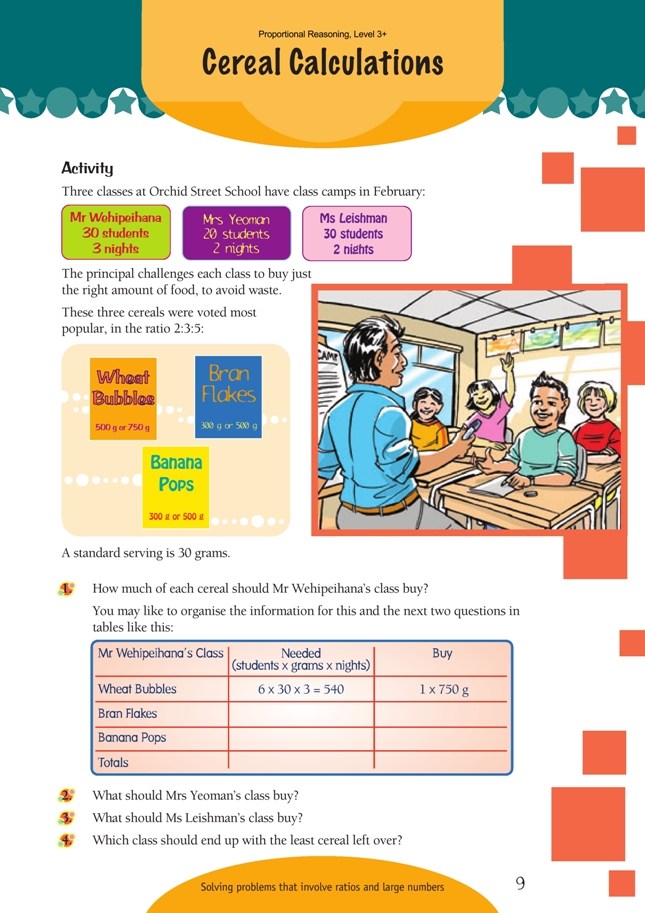This is a level 5 number activity from the Figure It Out series. It relates to Stage 8 of the Number Framework.
A PDF of the student activity is included.
Click on the image to enlarge it. Click again to close. Download PDF (1040 KB)
use ratio information to calculate amounts
Number Framework Links
Use this activity to help students:
• consolidate their knowledge of basic facts (stage 6)
• gain confidence in using partitioning strategies for addition and multiplication
(stages 6 and 7)
• apply their knowledge of ratio and proportion (stage 7).
This activity has an unusual number of details and dimensions. These include:
• 3 classes of different size
• 3 camps of different length
• 3 cereals, each available in 2 sizes
• a standard serving
• a 3-part ratio to be applied to cereal consumption
• a requirement that wastage be minimised
• numerous calculations involving x and +
• the summarising and interpretation of results.
Given this complexity of information, students are likely to need help working out how the parts relate to each other and how to bring so many facts together to answer the questions.
Once they are started, however, they will find that the numbers are user-friendly and that the table on the page gives them an excellent pattern to follow. If your students need a lot of guidance, work through question 1 with them step by step and then leave them to do questions 2 and 3 by themselves or with a classmate. You may need to discuss what kind of table is needed for the final question.
Here is a suggested approach for question 1:
1. Interpret the ratio.
2. Apply the ratio to the number of students in the class.
3. Work out quantities needed for each cereal and enter them in the table.
4. Decide what packet(s) to buy.
5. Add up the Needed and Buy columns. These two totals are required for question 4.
As mentioned above, the numbers in this activity have been chosen so that students can multiply and add them using familiar strategies, such as place-value partitioning and rounding and compensation. Discourage them from using calculators.
Extension
Students could investigate the prices of different-sized packets of their favourite cereals in the supermarket and compare the price per unit. They should think about how to compare the prices and decide what the best deal is. They could also do a comparative pricing survey of several different cereals or brands.
Answers to Activity
1. Splitting the class of 30 in the 2:3:5 ratio gives 6, 9, and 15 students preferring each kind of cereal.
2. Splitting the class of 20 in the 2:3:5 ratio gives 4, 6, and 10 students preferring each kind of cereal.
3. Splitting the class of 30 in the 2:3:5 ratio gives 6, 9, and 15 students preferring each kind of cereal.
4. Based on these estimates, Ms Leishman’s class would waste least (200 g).




